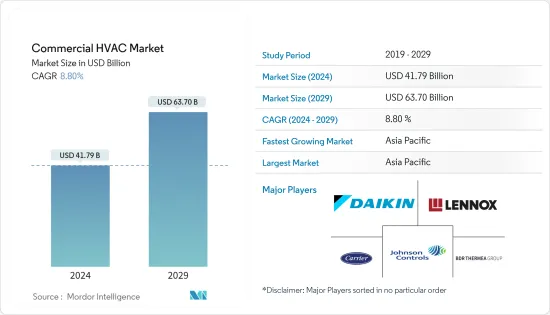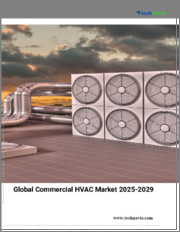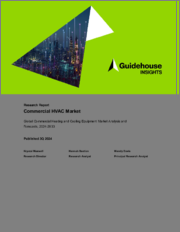
|
시장보고서
상품코드
1521792
상업용 HVAC : 시장 점유율 분석, 산업 동향 및 통계, 성장 예측(2024-2029년)Commercial HVAC - Market Share Analysis, Industry Trends & Statistics, Growth Forecasts (2024 - 2029) |
||||||
상업용 HVAC 시장 규모는 2024년 417억 9,000만 달러로 추정되며, 2029년까지 연평균 8.80%(2024-2029년) 성장해 637억 달러에 달할 것으로 예상됩니다.

주요 하이라이트
- 사무실, 식당, 호텔, 병원, 학교와 같은 상업용 건물은 거주자에게 쾌적한 공간을 제공하기 위해 냉난방 시스템이 필요합니다. 이러한 시스템은 적절한 온도와 환기를 유지하기 위해 사무실에서 널리 사용되어 직원의 생산성과 근무 조건을 개선하고 부적절한 습도 수준으로 인한 건강 문제를 예방하는 동시에 직원의 생산성과 근무 조건을 개선합니다.
- 에너지 효율이 높은 장비 도입을 위한 정부의 노력과 투자 증가는 시장 성장을 촉진할 것으로 보입니다. 예를 들어, 2024년 2월 인도 정부는 2024-25년 예산안에서 11조 1,100억 루피를 인프라 구축에 투자할 것이라고 발표하여 HVAC 분야 성장에 도움이 되는 환경을 조성했습니다. 이러한 투자는 Atmanirbhar Bharat와 같은 이니셔티브를 통한 정부의 자생력 강조와 함께 산업 확장에 더욱 박차를 가할 것으로 예상됩니다.
- 기후변화 목표를 달성하기 위해 유럽연합(EU)은 에너지 소비가 많은 건물을 더 빠른 속도로 개조하고 더 엄격한 에너지 절약 목표를 준수해야 한다고 선언했습니다. 이 초안은 각 주정부가 매년 3채의 국유 및 점유 건물을 개조하여 "거의 제로 에너지 건물"로 전환할 것을 의무화했습니다. 여기에는 병원, 정부 건물, 학교, 사회주택이 포함되며, 연간 70만 채 이상의 건물이 개조될 것으로 예상됩니다.
- 사무실 건설 증가, 온도 조건 상승, IoT 및 녹색 기술 채택 증가는 전체 상업용 HVAC 시장의 성장에 기여하는 촉진요인 중 일부입니다. 또한 영국 통계청(Office for National Statistics)에 따르면 2023년 1분기 영국 건설 산업의 총 부가가치(GVA)는 전년 동기 대비 40억 파운드 이상 증가했습니다.
- 에너지 소비 증가와 시스템 효율성 향상에 대한 요구로 인해 스마트 HVAC 시스템에 대한 수요가 증가하고 있습니다. 구매자들은 IoT 통합, 실시간 모니터링 및 향상된 제어 기능을 갖춘 스마트 솔루션을 점점 더 많이 찾고 있습니다. 이러한 지능형 시스템은 에너지 효율을 극대화하고, 편안함을 향상시키며, 실내 공간의 제어를 강화합니다.
- 세계적인 에너지 가격 상승으로 인해 에너지 효율이 높은 HVAC 시스템은 비용 절감 측면에서 매력적일 수 있습니다. 이러한 잠재적 이점에도 불구하고, 이러한 시스템 도입에 드는 초기 비용으로 인해 보급이 제한되어 시장 확대에 걸림돌이 될 수 있습니다.
- 상업용 HVAC 시장은 정부 규제 및 에너지 효율이 높은 장비의 채택을 촉진하기 위한 각 지역 정부의 새로운 노력과 같은 요인에 의해 크게 영향을 받습니다. 예를 들어, 지난 10년 동안 EU는 에너지 소비를 최소화하고 재생에너지 사용을 촉진하며 지구 온난화의 영향을 줄이기 위해 CO2 환산 배출량을 줄이기 위해 여러 종류의 법률을 도입했습니다.
상업용 HVAC 시장 동향
공조 및 환기 설비 수요 증가
- 도시화, 인프라 구축, 비즈니스 환경의 쾌적성에 대한 중요성 증가 등의 요인으로 인해 상업용 공조기기 시장이 크게 확대되고 있습니다.
- 공조 시스템이 상업용 건물에서 점점 더 보편화되고 있는 몇 가지 이유가 있습니다. 에어컨은 현대의 상업용 건물에서 쾌적한 분위기를 유지하는 데 필수적인 요소입니다. 수냉식 또는 냉매 시스템을 통해 공기를 움직여 온도를 효율적으로 낮추는 동시에 공기 중의 과도한 수분을 제거합니다.
- 상업용 공조 시스템은 가정용 공조 시스템보다 크기가 더 크고 복잡합니다. 이러한 시스템은 비즈니스 환경에서 최고의 편안함, 공기질 및 에너지 효율을 보장하기 위해 함께 작동하는 수많은 기본 구성요소로 구성됩니다. 적절하게 설계, 유지 관리 및 설치된 공조 시스템은 직원, 고객 및 비즈니스에 유리한 환경을 조성하는 동시에 에너지의 효율적인 사용과 재활용을 촉진하기 때문입니다. 에어컨은 온도 수준을 효과적으로 조절함으로써 외부의 더위와 상관없이 생산성 수준을 유지하는 데 도움이 됩니다.
- 또한, 실내 공기질에 대한 인식 증가, 지속가능성 규제, 사물인터넷(IoT)과 빌딩 자동화 시스템의 통합 등의 요인으로 인해 비즈니스 환경이 변화하고 있습니다. 이러한 변화는 기술 혁신과 시장 확대의 기회를 가져오고 있습니다.
- 또한, 여러 기업들은 이러한 상업용 에어컨 시스템에 대한 수요를 충족시키기 위해 다양한 제품을 출시하기 위해 지속적으로 투자하고 있습니다. 예를 들어, 2024년 4월 하이얼은 최신 '슈퍼 헤비 듀티' 에어컨 시리즈 출시를 발표했습니다. 이 새로운 시리즈에는 하이얼의 헥사 인버터와 슈퍼소닉 냉각 기술이 탑재되어 있습니다.
- 또한 2024년 5월, Carrier Midea India는 인도 최초의 Midea Cooling Solutions ProShop을 인도 최초의 Midea Cooling Solutions ProShop을 그룸그람에 오픈한다고 발표했습니다. 이 혁신적인 체험형 컨셉은 고객이 공조 제품을 구매할 때 경험하는 방식을 바꾸기 위해 고안된 것으로, 미데아 프로샵에서는 다양한 최첨단 공조 솔루션을 체험할 수 있습니다. 이 회사는 상업용 및 주거용 Midea HVAC 솔루션을 포괄적으로 갖추고 있습니다. 이는 주거, 중소기업, 사무실, 대형 상업용 건물 및 프로젝트 용도의 공조 요구를 충족하는 모든 종류의 VRF(가변 냉매 흐름) 시스템을 포괄합니다. 또한 다양한 분할형 에어컨, 덕트 유닛, 카세트 유닛, 타워 유닛도 포함됩니다.
- 인도 제조업체 Voltas는 2023-24 회계연도 에어컨 판매량이 200만 대를 돌파해 인도 에어컨 연간 판매량 중 사상 최대치를 기록했다고 밝혔습니다. 볼타스의 탄탄한 오프라인 및 온라인 판매망, 독창적인 신제품 출시, 냉방 제품에 대한 꾸준한 수요로 인해 연간 판매량이 35% 증가했으며, 4분기에는 72% 증가하며 성장세가 가속화됐습니다.
아시아태평양은 큰 폭의 성장이 예상
- 인도와 중국의 사무실, 쇼핑몰, 호텔, 데이터센터, 병원, 소매점의 확장은 이 지역 상업용 HVAC 시장의 주요 촉진요인입니다. 아시아태평양에서는 접객업이 HVAC 장비 및 서비스의 중요한 사용자입니다.
- 호텔 업계는 HVAC 시스템과 관련하여 사실상 다른 어떤 분야보다 더 많은 요구와 고려 사항이 있습니다. 투숙객의 편안함과 신뢰성에서 전반적인 효율성과 에너지 절약에 이르기까지 난방 및 환기에 대한 상업용 호텔의 복잡한 요구를 충족시키기 위해서는 종합적인 접근 방식이 필요합니다. 따라서, 이 지역의 호스피탈리티 부문의 부상은 시장 성장을 촉진할 것으로 예상됩니다.
- 2024년 1월, 인도 호텔 회사(Indian Hotels Company, IHCL)는 IFC의 TechEmerge 지속가능한 냉방 혁신 프로그램과 협력하여 1년 반 만에 9개의 파일럿 프로젝트를 완료했다고 발표했습니다. 이는 인도 호텔 산업에 효율적이고 기후 친화적이며 비용 효율적인 냉방 솔루션을 제공하기 위해 환경 친화적인 관행을 촉진하려는 회사의 확고한 의지를 강조하는 것입니다.
- 또한 이 지역의 많은 상업용 건물은 에너지 효율이 높은 공조 시스템 설치를 의무화하는 LEED와 같은 녹색 인증을 추구하고 있습니다. 국제에너지기구(IEA)가 발표한 보고서에 따르면 중국은 열펌프의 신규 판매량에서 세계를 선도하고 있으며, IEA의 보고서에 따르면 중국은 열펌프의 신규 설치가 많은 것으로 나타났습니다. 또한 중국은 히트 펌프와 같은 HVAC 시스템 설치에 특화된 가장 큰 인력을 보유하고 있으며, 히트 펌프 제조의 최대 시장 점유율은 45%를 차지합니다.
- 또한 이 지역의 HVAC 성장을 뒷받침하는 것은 이 시장의 여러 기업들입니다. 예를 들어, 2023년 11월 캐리어 코퍼레이션(Carrier Corporation)은 국가명문역사문화도시로 지정된 창사(長沙)에서 열린 연례 컨퍼런스에서 중국 전역에서 300명 이상의 상업용 HVAC 딜러를 유치했다고 발표했습니다. 이 행사를 통해 딜러들에게 혁신적인 솔루션, 고객의 탄소 중립화를 지원하는 회사의 계획, 차세대 지속가능한 솔루션을 가속화하기 위해 파괴적인 기술에 투자하는 방법에 대해 자세히 알아볼 수 있는 기회를 제공했습니다. 이번 행사는 HVAC 업계가 지능형 친환경 빌딩 솔루션을 통해 중국의 이중 탄소 전략 달성을 어떻게 지원할 수 있는지에 초점을 맞췄습니다.
- 또한 신흥국의 데이터센터, 쇼핑몰, 학교, 대학 등의 증가는 HVAC 시장의 수요를 촉진하고 있습니다. 아시아태평양에서는 첨단 데이터센터 건설에 대한 투자가 잇따르고 있습니다. 예를 들어, ST Telemedia Global Data Centres(STT GDC)는 2024년 4월 도쿄에서 두 번째 데이터센터 시설인 'STT Tokyo 2'의 기공식을 열고 일본의 중요한 디지털 인프라 수요를 지원할 것이라고 발표했습니다. 데이터센터 캠퍼스는 최대 70MW의 IT 용량을 제공하며, STT 도쿄 2 프로젝트는 완공 후 최대 38MW의 IT 용량을 창출할 것으로 예상됩니다.
상업용 HVAC 산업 개요
상업용 HVAC 시장은 세분화되어 있고 경쟁이 치열하며, 여러 유력 기업이 존재하고 있습니다. 시장 진입 기업들은 시장 점유율과 수익성을 높이기 위해 전략적 협력 이니셔티브를 활용하여 해외 소비자 기반을 확대하는 데 주력하고 있습니다. Carrier Corporation, Daikin Industries Ltd, BDR Thermea Group, Lennox International Inc, Johnson Controls International PLC와 같은 기업들이 이 시장에서 중요한 역할을 하고 있습니다.
- 2024년 5월 레녹스 인터내셔널은 지구 온난화 계수를 "최대 78%"까지 감소시키는 새로운 HVAC 제품군 출시를 발표했습니다. 레녹스의 새로운 난방, 환기 및 공조 제품은 종합적인 제품군을 제공하고 환경 친화적인 냉매 R454B를 사용하여 지구 온난화 계수를 최대 78 %까지 줄일 수 있습니다.
- 2024년 3월 파나소닉 주식회사는 친환경 자연 냉매를 사용하는 공동주택, 점포, 사무실 및 기타 경상업 시설용 상업용 공기청정 히트 펌프(A2W) 3기종을 새롭게 출시할 예정입니다.
기타 혜택
- 엑셀 형식의 시장 예측(ME) 시트
- 3개월간의 애널리스트 지원
목차
제1장 소개
- 조사 가정과 시장 정의
- 조사 범위
제2장 조사 방법
제3장 주요 요약
제4장 시장 인사이트
- 시장 개요
- 업계의 매력 - Porter's Five Forces 분석
- 공급 기업의 교섭력
- 소비자의 협상력
- 신규 참여업체의 위협
- 대체품의 위협
- 경쟁 기업 간의 경쟁 강도
- 업계 밸류체인 분석
- COVID-19의 부작용과 기타 거시경제 요인이 시장에 미치는 영향
제5장 시장 역학
- 시장 성장 촉진요인
- 주요 신흥 국가의 상업 건축 증가
- 에너지 효율적 기기에 대한 수요 증가
- 시장 과제
- 에너지 효율적 시스템의 높은 초기 비용
제6장 시장 세분화
- 부품 유형별
- HVAC 기기
- 난방 기기
- 공조·환기 기기
- HVAC 서비스
- HVAC 기기
- 최종 이용 산업별
- 호스피탈리티
- 상업 빌딩
- 공공시설
- 기타 최종 이용 산업
- 지역별
- 북미
- 유럽
- 아시아태평양
- 호주
- 뉴질랜드
- 라틴아메리카
- 중동 및 아프리카
제7장 경쟁 상황
- 기업 개요
- Johnson Controls International PLC
- Midea Group Co. Ltd
- Daikin Industries Ltd
- Robert Bosch GmbH
- Carrier Corporation
- LG Electronics Inc.
- Lennox International Inc.
- BDR Thermea Group
- Panasonic Corporation
- Danfoss A/S
제8장 투자 분석
제9장 시장 전망
ksm 24.08.01The Commercial HVAC Market size is estimated at USD 41.79 billion in 2024, and is expected to reach USD 63.70 billion by 2029, growing at a CAGR of 8.80% during the forecast period (2024-2029).

Key Highlights
- Any commercial building, including offices, restaurants, hotels, hospitals, and schools, needs heating and cooling systems to give its occupants a comfortable space. These systems are widely used in offices to maintain the right temperature and ventilation, which enhances worker productivity and working conditions while preventing health problems brought on by incorrect humidity levels.
- The increasing government initiatives and investments in the adoption of energy-efficient equipment will drive market growth. For instance, in February 2024, the Indian government's announcement to allocate INR 11.11 lakh crore for infrastructure in the 2024-25 budget created a conducive environment for the HVAC sector's growth. This investment, coupled with the government's focus on self-reliance through initiatives like Atmanirbhar Bharat, is expected to further fuel the industry's expansion.
- In an effort to meet climate change targets, the European Union declared that nations would have to renovate energy-guzzling buildings at a faster pace and adhere to stricter energy-saving targets. The draft proposal would require states to renovate three state-owned and occupied buildings each year to convert them into "near-zero energy buildings." This includes hospitals, government buildings, schools, and social housing, and it will amount to more than 700,000 renovated buildings per year.
- The increase in the construction of offices, rising temperature conditions, and rising adoption of IoT and green technologies are some of the driving factors contributing to the overall growth of the commercial HVAC market. In addition, according to the Office for National Statistics (United Kingdom), in the first quarter of 2023, the gross value added (GVA) of the construction industry in the United Kingdom was over GBP 4 billion higher than in the same period of the previous year.
- The market is witnessing a growing trend toward smart HVAC systems due to increased energy consumption and the need for higher system efficiency. Increasingly, buyers are looking for smart solutions with IoT integration, real-time monitoring, and improved controls. These intelligent systems maximize energy efficiency, improve comfort, and offer more control over interior spaces.
- The increasing energy prices worldwide make energy-efficient HVAC systems attractive for cost savings. Despite the potential benefits, the initial expenses of installing these systems could limit their widespread use and hinder market expansion.
- The commercial HVAC market is highly affected by factors such as government regulations and new initiatives by the governments of various regions to boost the adoption of energy-efficient equipment. For instance, over the past decade, several types of EU legislation have been introduced to minimize energy consumption, stimulate renewable energy use, and reduce CO2 equivalent emissions to decrease the impact of global warming.
Commercial HVAC Market Trends
Air Conditioning /Ventilation Equipment Witnessed Increasing Demand
- The market for air conditioning equipment in the commercial sector is expanding significantly due to factors such as increasing urbanization, infrastructure development, and the growing emphasis on comfort in business environments.
- There are several reasons why air conditioning systems are becoming more and more common in commercial buildings. Air conditioners are essential for preserving a comfortable atmosphere in contemporary commercial buildings. By moving air through water-cooled or refrigerant systems, these units efficiently reduce the temperature while also removing too much moisture from the air.
- Commercial air conditioning systems tend to be larger in size than domestic ones, and they are more complex. These systems are made up of a number of fundamental components that work together to ensure the highest comfort, air quality, and energy efficiency in business settings. This is because properly designed, maintained, and installed air conditioning systems create favorable environments for employees, customers, and operations while also facilitating the efficient utilization and recycling of energy. By regulating temperature levels effectively, air conditioning aids in sustaining productivity levels regardless of the external heat.
- Furthermore, the business landscape is changing due to factors like growing awareness of indoor air quality, sustainability regulations, and the integration of IoT (Internet of Things) and building automation systems. These changes present opportunities for innovation and market expansion.
- Moreover, several companies are constantly investing in introducing various products catering to the demand for these air conditioning systems in the commercial segment. For instance, in April 2024, Haier announced the launch of its latest range of "super heavy-duty" air conditioners. The new range comes with the company's Hexa Inverter and Supersonic cooling technologies.
- Further, in May 2024, Carrier Midea India Pvt. Ltd announced the opening of India's first Midea Cooling Solutions ProShop in Gurugram. This innovative experiential concept is designed to transform the customer buying experience for air-conditioning products. A wide variety of cutting-edge air conditioning solutions are available for exploration at the Midea ProShop; the company offers a comprehensive selection of Midea HVAC solutions for commercial and residential applications. This covers a full range of VRF (Variable Refrigerant Flow) systems to meet the air-conditioning needs of residential, small businesses, offices, large commercial buildings, and project applications. It also includes a variety of split air conditioners, ducted units, cassette units, and tower units.
- Voltas, an Indian manufacturer, reported sales of over 2 million air conditioners in FY 2023-24, the largest-ever annual sales of ACs in India, according to the company. The company's robust offline and online distribution network, creative new launches, and a steady demand for cooling products were all factors leading to an annual volume growth of 35%, which was accelerated by a 72% growth in Q4.
Asia-Pacific is Expected to Witness Significant Growth
- The expansion of offices, malls, hotels, data centers, hospitals, and retail outlets in India and China is a major driver for the region's commercial HVAC market. In Asia-Pacific, the hospitality sector is a significant user of HVAC equipment and services.
- The hotel industry has more needs and considerations compared to virtually any other sector when it comes to HVAC systems. A comprehensive approach is needed to meet the complex needs of commercial hotels for heating and ventilation, from guest comfort and reliability to overall efficiency and energy savings. Thus, the rising hospitality sector in the region is expected to drive the market's growth.
- In January 2024, Indian Hotels Company (IHCL) announced the completion of nine pilot projects in collaboration with IFC's TechEmerge Sustainable Cooling Innovation Program within a span of 18 months. This highlights the firm's unwavering commitment to fostering environmentally responsible practices in order to provide efficient, climate-friendly, and cost-effective cooling solutions for India's hospitality industry.
- Many commercial buildings in the region are also pursuing green certifications like LEED, which mandate the installation of energy-efficient HVAC systems. According to the report published by the International Energy Agency, China is the global leader in new heat pump sales. According to the IEA report, China has a large number of new heat pump installations. Furthermore, China boasts the largest workforce dedicated to installing HVAC systems like heat pumps and holds the largest market share in heat pump manufacturing, accounting for 45%.
- Several players in the market are also supporting the growth of HVAC in the region. For instance, in November 2023, Carrier Corporation announced that it had hosted more than 300 commercial HVAC dealers from across China during its annual conference in the designated National Famous Historical and Cultural City of Changsha. Through this event, the company will provide dealers the opportunity to learn more about its innovative solutions, the company's plan to help customers become carbon neutral, and how it is investing in disruptive technologies to accelerate next-generation sustainable solutions. The event focused on how the HVAC industry can help China achieve its dual carbon strategy with intelligent and green building solutions.
- Furthermore, the growing number of data centers, malls, schools, and universities, among others, in developing countries is driving the demand in the HVAC market. Asia-Pacific is witnessing several investments in the construction of advanced data centers. For instance, in April 2024, ST Telemedia Global Data Centres (STT GDC) announced the groundbreaking for its second data center facility in Tokyo, STT Tokyo 2, to support the demand for critical digital infrastructure in the country. The data center campus will provide up to 70 MW of IT capacity, while the STT Tokyo 2 project is estimated to generate up to 38 MW once it is completed.
Commercial HVAC Industry Overview
The commercial HVAC market is fragmented, favorably competitive, and has several prominent players. The market players are focusing on expanding their consumer base across foreign countries by leveraging strategic collaborative initiatives to increase their market share and profitability. These enterprises leverage strategic collaborative initiatives to boost their market share and profitability. Companies such as Carrier Corporation, Daikin Industries Ltd, BDR Thermea Group, Lennox International Inc., and Johnson Controls International PLC are significant players in the market.
- May 2024: Lennox International announced the launch of a new HVAC line that reduces global warming potential 'by up to 78%'. The new Lennox heating, ventilation, and air conditioning products will offer a comprehensive range of products and will use the environmentally responsible refrigerant R454B, which reduces global warming potential by as much as 78%.
- March 2024: Panasonic Corporation announced the release of three new models of commercial air-to-water (A2W) heat pumps using environmentally friendly natural refrigerants for multi-dwelling units, stores, offices, and other light commercial properties.
Additional Benefits:
- The market estimate (ME) sheet in Excel format
- 3 months of analyst support
TABLE OF CONTENTS
1 INTRODUCTION
- 1.1 Study Assumptions and Market Definition
- 1.2 Scope of the Study
2 RESEARCH METHODOLOGY
3 EXECUTIVE SUMMARY
4 MARKET INSIGHTS
- 4.1 Market Overview
- 4.2 Industry Attractiveness - Porter's Five Forces Analysis
- 4.2.1 Bargaining Power of Suppliers
- 4.2.2 Bargaining Power of Consumers
- 4.2.3 Threat of New Entrants
- 4.2.4 Threat of Substitute Products
- 4.2.5 Intensity of Competitive Rivalry
- 4.3 Industry Value Chain Analysis
- 4.4 Impact of COVID-19 Aftereffects and Other Macroeconomic Factors on the Market
5 MARKET DYNAMICS
- 5.1 Market Drivers
- 5.1.1 Growing Commercial Construction in Major Emerging Economies
- 5.1.2 Increasing Demand For Energy Efficient Devices
- 5.2 Market Challenges
- 5.2.1 High Initial Cost of Energy-efficient Systems
6 MARKET SEGMENTATION
- 6.1 By Type of Component
- 6.1.1 HVAC Equipment
- 6.1.1.1 Heating Equipment
- 6.1.1.2 Air Conditioning /Ventillation Equipment
- 6.1.2 HVAC Services
- 6.1.1 HVAC Equipment
- 6.2 By End-user Industry
- 6.2.1 Hospitality
- 6.2.2 Commercial Buildings
- 6.2.3 Public Buildings
- 6.2.4 Other End-user Industries
- 6.3 By Geography ***
- 6.3.1 North America
- 6.3.2 Europe
- 6.3.3 Asia-Pacific
- 6.3.4 Australia
- 6.3.5 New Zealand
- 6.3.6 Latin America
- 6.3.7 Middle East and Africa
7 COMPETITIVE LANDSCAPE
- 7.1 Company Profiles
- 7.2 Johnson Controls International PLC
- 7.3 Midea Group Co. Ltd
- 7.4 Daikin Industries Ltd
- 7.5 Robert Bosch GmbH
- 7.6 Carrier Corporation
- 7.7 LG Electronics Inc.
- 7.8 Lennox International Inc.
- 7.9 BDR Thermea Group
- 7.10 Panasonic Corporation
- 7.11 Danfoss A/S



















